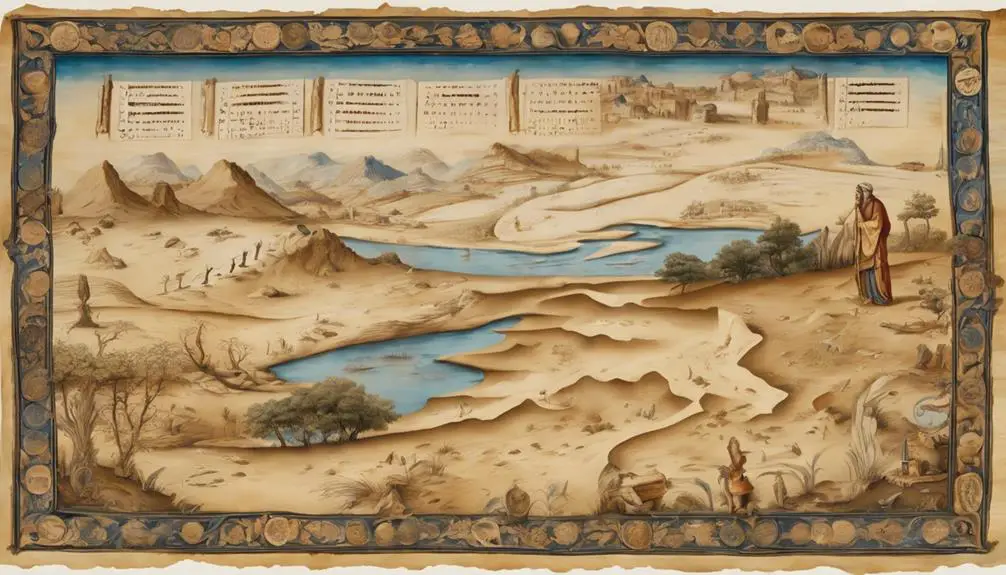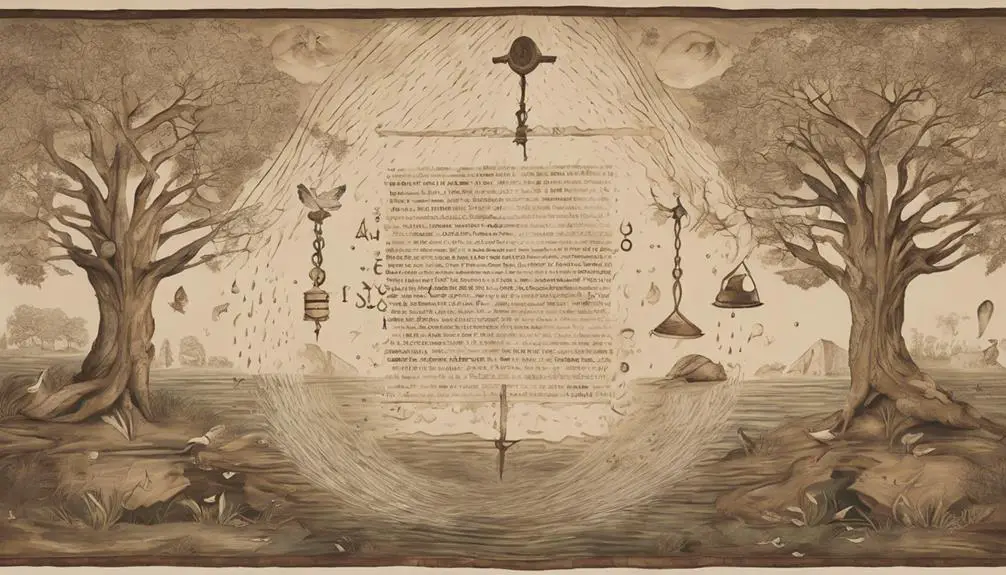Observe the profound significance of times and seasons in the Bible, unlocking deeper insights into biblical narratives and their impact on modern Christianity.

Understanding Times and Seasons in the Bible
You might think that the mentioning of times and seasons in the Bible are just mere details, but they're actually more than that. These references hold deep symbolic meanings and provide context to the stories narrated.
They're not just about the passing of days or changing of seasons, but markers of significant events and indicators of God's providence. By understanding their importance, you'll gain a whole new perspective on biblical narratives.
Now, wouldn't it be intriguing to uncover these hidden layers of meanings and see how they influence modern Christianity?
Key Takeaways
- Numerology and seasonal symbolism in the Bible provide profound teachings and deeper understanding of divine truths.
- Detailed biblical timelines, like the Great Flood, offer valuable insights into biblical times and seasons.
- Specific events, such as Christ's wilderness journey, illustrate the significance of times and seasons in spiritual discipline and preparation.
- Knowledge of biblical times and seasons is fundamental in understanding the roots of modern Christianity's rituals, beliefs, and moral code.
Biblical Significance of Numbers

Often overlooked, the significance of numbers in the Bible provides profound insight into the text's deeper meanings and recurring themes. You've likely noticed certain numbers recurring in scripture. It's not a coincidence. Those recurring numbers aren't random; they're part of an intricate system known as Spiritual Numerology.
In Spiritual Numerology, each number carries specific spiritual significance. For instance, the number seven often symbolizes completion or perfection, as seen in the seven days of creation. Three, on the other hand, frequently references the divine, as in the Holy Trinity.
These Numerological Interpretations extend beyond single digits. For example, the number 12, as in the twelve tribes of Israel or the twelve apostles, is often associated with divine government and authority. Also, forty, which repeatedly appears in contexts of testing or judgment, such as the forty days of the flood or Jesus' forty days in the wilderness, represents a period of trial or probation.
Understanding these numerological patterns can greatly enrich your interpretation of biblical texts, allowing you to discern deeper theological and spiritual meanings. Take note: the Bible's numerology isn't just math; it's a divine language waiting to be deciphered.
Seasonal Symbolism in Scripture

Just as numerical patterns illuminate the Bible's deeper meanings, seasonal symbolism in scripture also offers insightful layers of interpretation. This symbolism often utilizes 'Harvest Metaphors' and 'Feast Celebrations' to convey profound teachings.
Consider these four aspects:
- Spring symbolizes new beginnings and resurrection. The Passover, a spring feast, celebrates Israel's deliverance from Egypt, foreshadowing Christ's resurrection.
- Summer often represents growth and maturation. Biblical harvest metaphors, used in parables, signify spiritual growth and judgment.
- Autumn is associated with harvest and thanksgiving. The Feast of Tabernacles, an autumn celebration, commemorates the Israelites' wilderness journey, encouraging gratitude for God's provision.
- Winter typically signifies dormancy and death, yet it also anticipates renewal, as exemplified in the Christmas narrative's promise of Christ's birth.
These seasonal symbols in scripture aren't mere literary devices; they're spiritual keys unlocking deeper divine truths. As you delve into the Bible, understanding these symbols will enrich your interpretation, making your reading more insightful and rewarding. Remember, the Bible isn't a surface-level document – it's a profound spiritual guide embedded with layers of divine wisdom, waiting to be discovered.
Decoding The Great Flood's Timeline

To unravel the timeline of the Great Flood, it's essential to meticulously examine biblical passages, particularly those in Genesis, and cross-reference them with historical and scientific data. The importance of Noah's preparation is underscored in Genesis 6:14-16, where specific instructions for the ark are provided. With no indication of time lapse between these instructions and the start of the flood, we can infer that Noah and his family had a limited window for preparation.
In Genesis 7:11-12, we're told the flood began on the seventeenth day of the second month of Noah's 600th year. This precise detail gives us a fixed point in the timeline. The flood's aftermath is described in Genesis 8, with the waters receding over a period of months. By comparing the dates given in Genesis 7 and 8, we deduce that the flood's duration was approximately one year and ten days.
Decoding the timeline of the Great Flood requires diligence, but it offers valuable insight into understanding times and seasons in the Bible. As we continue, let's not lose sight of the importance of these historical events in shaping biblical narratives.
Christ's Wilderness Journey: A Closer Look

Delving into Christ's forty-day wilderness journey, as narrated in the New Testament, provides a remarkable lens into the distinct periods and events that shaped his ministry. This pivotal period in Christ's life was marked by Wilderness Temptations and profound moments of Christ's Solitude.
- Christ's Solitude: This period was a time of deep introspection and preparation. Christ distanced himself from society's distraction, seeking spiritual clarity in solitude. This solitude wasn't isolation but a purposeful retreat to connect with the Father.
- Wilderness Temptations: The wilderness journey was also characterized by temptations. Satan sought to exploit Christ's vulnerability, but Christ used scripture to counter each temptation, demonstrating the importance of knowing and applying God's word.
- Christ's Fasting: Christ fasted for forty days, a testament to his spiritual discipline and a model for believers. This fasting period wasn't merely abstention from food but a time of intense prayer and communion with God.
- Divine Affirmation: Post this wilderness journey, Christ returned in the power of the Spirit, signalling divine affirmation of his preparation. This formed the foundation of his public ministry.
Understanding these elements brings depth to our comprehension of Christ's wilderness journey and its significance.
Impact of Biblical Times on Modern Christianity

The profound influence of biblical times, particularly events such as Christ's wilderness journey, continues to shape the practices, beliefs, and moral framework of modern Christianity. You can see this impact clearly in the Christian rituals origin, where early church influence plays a significant role.
Baptism, for instance, a central ritual in Christianity, has its roots in the early church. It's a direct outcome of Christ's baptism by John the Baptist in the Jordan River. Moreover, Communion, or the Eucharist, reenacts Jesus' Last Supper with His disciples, a pivotal moment from biblical times.
The early church influence is even evident in the hierarchical structure of modern Christianity. The roles of bishops, priests, and deacons have been carried over from the first-century ecclesiastical framework. These positions, established by the Apostles, help maintain the continuity and integrity of Christian teachings.
Furthermore, the moral code that modern Christians adhere to is largely derived from the Ten Commandments and Jesus' teachings. The Sermon on the Mount, for example, is a primary source of Christian ethics.
Therefore, understanding biblical times isn't merely an academic exercise; it's a key to comprehending the foundation and ongoing development of Christian faith and practice.
Frequently Asked Questions
How Did the Ancient Israelites Track Time and Seasons in the Biblical Era?
You're wondering how the ancient Israelites tracked time and seasons. They largely relied on lunar observations and simple timekeeping instruments. The moon's phases indicated the passage of time, while agricultural patterns provided seasonal cues.
They didn't have modern calendars, but their system was impressively accurate. It's fascinating how resourceful they were, using the tools and knowledge available to them to maintain a sense of time in their daily lives.
What Are Some Biblical Events That Happened During Specific Times or Seasons?
You're asking about biblically significant events tied to specific times or seasons.
The Bible's rich with seasonal symbolism. For instance, Jesus' resurrection during spring hints at new life. Harvest seasons often symbolize abundance and blessings.
Also, the timing of biblical prophecies is critical. Daniel's 70 weeks prophecy, for example, was fulfilled exactly at the time of Jesus' crucifixion.
How Do Different Bible Translations Interpret the Concept of Time and Seasons?
Different Bible translations interpret the concept of time and seasons using temporal metaphors and chronological symbolism. You'll find that seasons often symbolize stages of life or spiritual states.
Time, on the other hand, is depicted through events like sunrise and sunset. It's fascinating to see how each translation captures these nuances, offering you a richer understanding of the biblical text.
How Did the Agricultural Cycles of Ancient Israel Influence the Biblical Narrative?
The agricultural cycles of ancient Israel deeply influenced the biblical narrative. You see farming rituals' significance and crop-based symbolism throughout the text.
For instance, harvest times often symbolize abundance and divine blessings, while barren periods represent trial and tribulation. This tie to the land and its cycles gave the ancient Israelites a tangible way to understand and relate to divine messages.
How Has the Understanding of Biblical Times and Seasons Evolved in Contemporary Theology?
Today, your understanding of biblical times and seasons has evolved through theological implications and modern interpretations. Scholars now recognize that the ancient Israelites' agricultural cycles deeply influenced biblical narratives.
This fresh perspective reveals how seasons aren't just background scenery, but integral elements in the stories. So, you're not just reading these tales; you're experiencing a rich tapestry of life's rhythms from an ancient era, connecting it to your modern faith journey.
Conclusion
Understanding the times and seasons in the Bible provides a richer comprehension of Scripture. The symbolic significance of numbers, seasonal symbolism, and timelines like The Great Flood and Christ's wilderness journey, all play crucial roles.
Recognizing these elements not only deepens our biblical knowledge but also enhances our modern Christian faith. By exploring these aspects, we can better appreciate the intricate, divine design woven into every biblical narrative, reaffirming our faith and enriching our spiritual journey.



Sign up